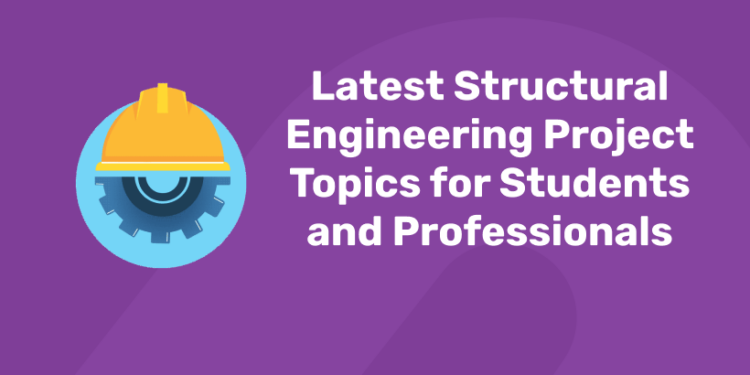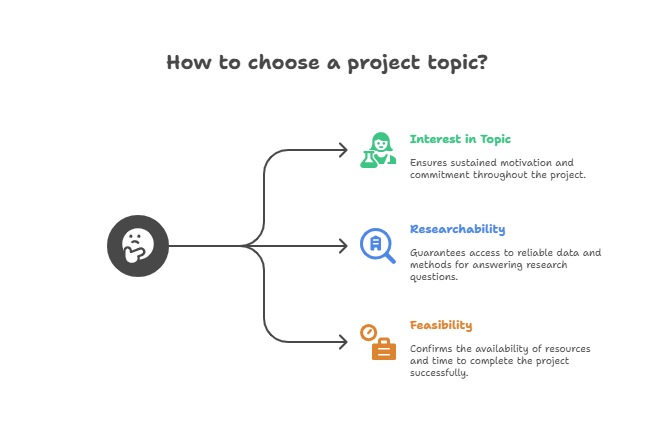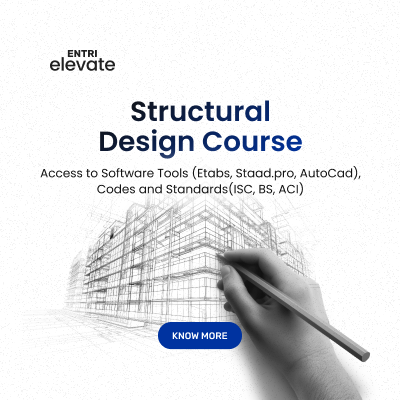Table of Contents
Structural engineering is a branch of civil engineering that involves the application of the laws of physics, mathematics, and empirical knowledge to the safe design of the “bones” and load-bearing elements of man-made structures. Modern structural engineering provides a large and detailed body of knowledge that can accurately predict the properties of various shapes and materials used in structures to withstand the loads and stresses of structures.
Structural engineers are trained professionals who are responsible for ensuring that the structures we use in our daily lives, such as bridges and tall buildings, are safe, stable and will not collapse under applied loads. They do this by applying their engineering knowledge to specify different types of building materials in different shapes and geometries and design structures that can withstand the pressures and stresses of their environment, such as gravity loads, storms and earthquakes.
Build A Career In Structural Engineering! Get Free Demo Classes!!
Latest Structural Engineering Project Topics for Students and Professionals
Structural engineering final year projects are essential in a student’s academic journey, bridging the gap between theoretical knowledge and real-world application. These projects are a great way for students to gain hands-on experience solving complex engineering problems. A strong project can significantly increase a student’s employability and demonstrate their ability to apply their learning to practical challenges.
By working on a structural engineering project, students hone their technical skills and become more confident in their problem-solving abilities, often leading to new insights and innovations that contribute to the field.
Sustainable and Green Building Projects
-
Design of a Net-Zero Energy Commercial Building
This project explores the architectural and structural design of a commercial building that produces as much energy as it consumes annually. The key focus of the project will be passive design strategies like orientation, natural ventilation, and thermal mass. Energy modeling tools such as eQuest, EnergyPlus, or DesignBuilder will be integrated with the system.
Incorporating photovoltaic panels, wind turbines, and solar water heating systems will help to make it more renewable model project. And the main challenges we face like Structural load accommodation of energy systems and insulation materials.
-
Use of Recycled Concrete Aggregate in Structural Members
Investigate the reuse of construction waste as coarse and fine aggregates in concrete. The main objective of the project will be to evaluate compressive strength, workability, and durability.
Use M25–M40 grade concrete and replace aggregates in varying percentages will help you to analyse the project. The tools we are going to use will be UTM testing, SEM analysis. The main outcome of the project will be Sustainable alternative with a lifecycle cost comparison.
-
Bamboo as a Sustainable Reinforcement Material
Bamboo is renewable, strong, and abundant in many regions, making it a viable reinforcement substitute.
- Scope: Analyze tensile strength, bonding behavior with concrete, and coating solutions.
- Application: Low-rise residential buildings or disaster-relief shelters.
- Testing: Flexural, tensile, and corrosion resistance tests.
-
Design and Analysis of a Green Roof System
Design a load-bearing rooftop garden system for residential/commercial buildings.
- Impact Areas: Structural load due to soil, plants, and moisture content.
- Drainage: Efficient water runoff and root barrier layers.
- Thermal Performance: Insulation and indoor temperature reduction.
- Software: ETABS, SAFE, and energy modeling tools.
Bridges and Flyovers Based Project
-
Bridge Pier Scour in Tidal Environments
Estimating bridge pier scour in tidal areas is challenging because current models, designed for rivers, fail to account for the unique sediment transport in tidal flows. While complex hydrodynamic models exist, they are impractical due to high data demands, computational cost, and their reliance on less accurate empirical equations for final predictions.
To address this, the WAVES program was developed. This multicomponent continuum model combines established scour theories with tidal and river hydraulics. WAVES uniquely quantifies the effects of downdrafts and horseshoe vortices, which are key drivers of scour around bridge piers.
The study highlights several conclusions:
- Many existing scour models are unsuitable for tidal environments.
- WAVES offers a significant improvement by providing a temporal, cost-effective method for predicting scour depth over time, rather than just single events.
- By estimating the probability of scour depth over time, WAVES supports a risk-based bridge design approach, enabling safer new bridge construction and better management of existing structures in estuarine environments.
-
Warehouse Redesign Process
Warehousing is a critical, cost-intensive component of modern supply chains. The initial design phase is paramount, as it dictates most strategic and tactical decisions. However, current academic research often analyzes existing systems without offering systematic methods for warehouse redesign. There’s a clear need for a structured procedure applicable to various warehouse types.
This thesis addresses that gap by developing a seven-step redesign procedure specifically for production warehouses, identifying key challenges encountered during each step. Utilizing a case study approach with both quantitative and qualitative methods, the research focuses on storage and reprocessing steps.
The study aimed to select the most suitable redesign method, considering spatial reduction, existing equipment, and cost efficiency. It also evaluated the current warehouse system’s performance to prevent repeating past mistakes in the new design. A storage allocation policy was discussed as part of the redesign, proposing a framework for a component storage system.
The findings offer valuable insights for other production warehouses, though further research is recommended to generalize these results and develop new rework methods for all warehouse types.
Soil Steel Composite Bridges
The need to explore effective solutions to today’s technical problems is becoming essential in today’s market development. Soil Steel Composite Bridges (SSCB) are considered to be well competitive in terms of feasibility and construction.
The primary objective of this study is to provide a comprehensive comparative study of two well-known SSCB design methods, which are the Pettersson-Sundquist design method (developed in Sweden) and the Klöppel & Glock design method (developed in Germany). In addition, to better understand the behavior of SSCBs, the study also includes Finite Element Modeling (FEM) using PLAXIS 2D from three case studies and compares the model results with field measurements.
Design Comparison addresses design concepts, assumptions, and limitations for both design methods, where complete design procedures for a defined case study are implemented and compared.
The results of the FEM analysis show a rational result of field measurements for the response of the structure when backfilling and close results even for normal loads. While the design comparison shows how the different approach in both design methods in design constraints and assumptions has an important impact on the results, where soil failure in the Klöppel & Glock design method can drive the design for low cover heights, while crown formation plastic hinge is more controllable in the method of the Pettersson-Sundquist proposal.
-
Life Cycle Assessment of Concrete Structures
Concrete structures involve substantial material and energy investments, leading to significant environmental impacts. This study uses Life Cycle Assessment (LCA) to compare the environmental footprint of building a bridge versus a tunnel.
Focusing on the construction phase, a simplified LCA analyzed NOx, SO2, and CO2 emissions, alongside energy consumption, global warming potential, and photochemical oxidant generation, using REciPE method characterization factors. The study compared material production, construction processes, and transportation phases.
Results indicate the bridge has higher environmental impacts than the tunnel, with concrete quantity heavily influencing the outcome. Crucially, producing concrete on-site dramatically reduces environmental impact; for the bridge, it cut CO2 emissions, global warming potential, and energy consumption by over 60%.
A key limitation was data collection, as missing or disparate public database information led to a lack of thoroughness and precision in the life cycle inventory.
The Design of an Overpass Crossing on Railway
The designs and construction of bridges in the former USSR, especially in Russia, are not very familiar to foreign engineers. Many advanced structural theories and design procedures have been developed.
The development of bridge engineering is based on previous experience and historical aspects. Russian experience in bridge construction certainly has its specifics. The design of the bridge is carried out in accordance with local standards and specifications. This study deals with the basic rules and standards in the design of bridges in the north of Russia, the work contains an overview of Russian construction concepts. The paper shows the design of typical concrete bridges including all calculations and analyzes for the future stability of the bridge as well as drawings for visualization.
The result of the work are conclusions based on the execution of the required project calculations, drawings, processing of the final estimate and construction preparation. There are also some notes on Russian construction systems, computer programs for design and calculations, and finally a comparison of Russian construction standards and the Eurocode.
-
Capacity assessment of a Single Span Arch Bridge
The aim of this project is to assess the load-bearing capacity of the Glomman Bridge outside the Swedish city of Orebro. Glomman Bridge is an unreinforced concrete single-span arch bridge with backfill.
The failure criterion used in this study is that the bridge collapses when any section in the concrete arch reaches its ultimate bearing capacity. In fact, the bridge can handle even more loads. When cross-sectional capacity is reached, a hinge is formed and the arch transfers forces to other parts of the arch that can carry higher stresses. The actual bridge does not collapse until the fourth hinge and thus the mechanism is formed. In order to be able to calculate the cross-sectional forces in the arch, it was necessary to know the effects of the loads on the arch as they were carried along the bridge.
For this purpose, influence lines were obtained from a 2D finite element model created in ABAQUS, a general finite element analysis software. A calculation routine was created in Matlab, a software for numerical calculations, to find the least favorable load combination. The routine was created to find the worst case among the various load cases and combine the normalized axle pressures with the current number of axles.
-
Effect of Dead, Live, and Blast Loads on a Suspension Bridge
American bridges require thorough analysis under various loading conditions, including dead, live, and occasional loads. While AASHTO addresses ship impact, seismic vulnerability, and vehicle collisions, specific design criteria for blast resistance are lacking.
This study provides initial guidance for blast load analysis on suspension bridges, advocating for future research to develop specific blast resistance standards. The research also investigated live load effects, informing cost allocation based on vehicle impact on bridge decks.
A 3D non-linear finite element model of the Chesapeake Bay Bridge (west suspension portion) was created using “Visual Bridge Design System” (VBDS) software to analyze vehicle-bridge interaction and dynamic loading for cost allocation. This model, incorporating detailed truck designs, yielded results consistent with Maryland State Road Commission data, demonstrating VBDS’s potential for such investigations. Additionally, the bridge was modeled in SAP2000 to perform a non-linear blast load analysis.
Take the next step in your career by enrolling in the best Structural Design course in Kerala with Entri today!
-
Dynamic Analysis of a Portal Frame Railway Bridge
Investigating the dynamic behavior of high-speed railway bridges is crucial for safety. This project focuses on Soil-Structure Interaction (SSI), which describes how bridge foundations and surrounding soil influence the bridge’s response to dynamic train loads.
A 3D finite element model of an existing portal frame railway bridge was developed, incorporating three boundary conditions: clamped, static stiffness, and frequency-dependent stiffness (SSI). Simulations with a two-car train revealed that the SSI model with frequency-dependent boundary conditions better matches measured bridge data, showing improved damping of free vibrations and more accurate natural frequencies. While peak acceleration differences between models were minor, the clamped model proved non-conservative by underestimating accelerations. Train speed significantly impacted maximum acceleration, free vibrations, and natural frequencies.
Further research with longer trains is recommended to study resonance phenomena and the effect of natural frequencies at various speeds. More measurements are also needed to draw broader conclusions and calibrate model parameters.
Highway Engineering
-
Comprehensive Highway Corridor Planning With Sustainability Indicators
This project develops the Model of Sustainability and Integrated Corridors (MOSAIC) to select the best program-level plans for corridors in Maryland by estimating the sustainability of multimodal highway improvement options in the early stages of transportation planning and environmental screening processes with minimal staff time requirements. and other resources.
Six categories of sustainability indicators (mobility, safety, socio-economic impact, natural resources, energy and emissions and costs) and more than thirty sustainability performance measures were defined as evaluation criteria for the selection of highway corridor improvement options. Currently, MOSAIC is considering a no-build case and two highway improvement options, including adding a general purpose lane and converting interchanges to interchanges. A mode choice model was also introduced for future study of multimodal enhancement types.
-
An Alignment Optimization Model for a Simple Highway Network
To improve the traffic performance in this road network, it is usually considered to add a new highway to the existing road network. However, finding a new highway that best improves the existing network is a very complex problem, as many factors affect road construction.
In addition to changes in traffic flow patterns due to a new freeway, various costs associated with freeway construction as well as design specifications, safety, environmental, and political issues affect such a project.
Until recently, many studies have separately addressed the problems of freeway route optimization and network design. However, no models have been found that comprehensively and effectively integrate these issues. This study seeks to find a realistic three-dimensional freeway layout that best enhances the existing network, taking into account its cost, geometric design, and environmental impacts on the study area
Beams and Columns-based Civil Project Topic
-
Seismic Design of Knee Elements for Steel Frames
Knee members are required to provide energy absorption through repeated large deformations without suffering collapse or instability. This work describes the development of various designs of knee elements and their performance evaluation. It is shown that the dissipative mechanism of the yielding shear band is advantageous because it is independent of the moment distribution and does not affect the joints and extends the dissipative zones over their entire lengths. Extensive finite element modeling and experimental testing was performed.
In the shear yielding regime, excellent performance was achieved using standard hot-rolled profiles modified by adding web stiffeners to prevent localized failure in buckling. Weakening the webs of the knee member so that they yield very early in an earthquake has potential benefits, but has been shown to be unsafe as it promotes premature failure of the member.
A knee element model was developed for the nonlinear dynamic analysis of the whole building. Time history analyzes showed that frames with knee braces with a developed knee element have large global ductility and excellent performance.
The results obtained by different pushover analysis methods (Eurocode 8, FEMA-356 and ATC-40) were compared with the results obtained by time history analysis. In addition, the FEMA-356 method, which includes a more accurate representation of the significant post-yield stiffness of the structure, provided the closest agreement with the time history analyzes and is recommended for the design of frames with knee braces.
-
Model Calibration of a Wooden Building Block
The construction of multi-storey buildings from light materials has recently become widespread. Using lightweight materials such as wood has many benefits for the environment. However, one of the disadvantages of the light material is the acoustic performance.
The transmission of sound and vibration through floors in multi-storey buildings made of wood is a disadvantage that must be taken into account. There are many studies that have addressed this issue.
The most common is to do finite element models and experiments in the laboratory. In these studies, the material properties in the FE model are probably often adjusted to correlate with the laboratory experiments, as there is a large spread of material properties in the literature.
However, this work tries to elaborate the actual material properties of the included wooden elements. Dynamic testing is performed to determine the variance (here variance means the gap between material properties) in the material properties of wood members.
The tested materials are chipboards and two types of wooden beams. The investigated beams are both normal wooden beams and laminated veneer lumber beams. When the dynamic behavior of the wooden parts is known, they are assembled into two small floor systems. The floor systems consist of four beams and one wooden board. The assembly is dynamically tested in the laboratory and in the FE software. The FE model used known material properties for each individual building part.
The results from the FE model correlate well with the laboratory tests. This shows that when the material properties are known, the finite element model can predict the actual behavior. However, the investigated material properties show a large variance from beam to beam, etc. and a better knowledge of the material properties of the wood parts used is needed.
-
A Study of the Correlation Between Soil-rock Sounding and Column Penetration Test Data
Lime-cement columns have been used in Sweden to improve poor soil conditions since the 1970s. The method is cheap and flexible, but difficult to test because the columns are manufactured in-situ. Many test methods have been developed over the years to test column strength.
Most of these must be evaluated using an empirical correction factor known as the taper factor. The column penetration test, KPS, is the most commonly used method in Sweden, it is considered reliable because a large part of the column cross-section is tested. The problem is that the probe is easily deflected from the column into the softer surrounding soil.
Today, a pre-drilled guide hole, the soil-rock probe, helps the probe stay vertical. Although soil-rock probing is not commonly used to assess column strength, penetration resistance is recorded. A visual comparison between the plotted penetration resistances from the two methods shows similarities in both the hard and soft regions of the columns.
The relationship can be measured using statistics such as the correlation coefficient. A strong correlation was also found, suggesting that a similar equation used to evaluate the undrained shear strength from column penetration tests can be applied to drill rock data. The statically pressurized column penetration test probe and the rotated soil-rock probe drilling are likely to cause different failure modes in the column. This means that different empirical taper factors are needed when evaluating the undrained shear strength.
-
Preliminary Design and Multi-Criteria Analysis of Solutions for Widening an Existing Concrete Bridge
Europe experienced the destruction of much infrastructure during World War II, followed by reflation and strong economic growth over the next two decades, allowing for a more permanent and permanent situation.
For a classic bridge with a lifespan generally around 80 years, it should be noted that these post-war structures will either need to be replaced or seriously strengthened in a few years. Furthermore, as needs also change over time, the transport infrastructure built during these years may no longer be adapted to actual needs – some bridges may thus need to be widened.
A case study was chosen to simulate the conditions under which the widening of such a bridge can be carried out. This road bridge in Vierzon, France is quite simple as it is made of simply supported prestressed concrete beams and reinforced concrete piers.
An evaluation of the performance of the solution is carried out according to three criteria – duration of the works, cost of the works and environmental impact – in order to provide recommendations on the optimal solution.
The results show that, despite the quick installation, adding steel beams is more expensive and has a greater environmental impact than adding prestressed concrete beams. Regarding the modification of the pillars, a solution proposing the expansion of the existing pillars is more suitable than the addition of new extra pillars according to all criteria.
Consequently, among all analyzed solutions, the optimal one is also the simplest one. Finally, limitations of the study and some suggestions for improvement are presented.
Take the next step in your career by enrolling in the best Structural Design course in Kerala with Entri today!
Criteria For Choosing A Project Topic
1: What is the primary purpose of structural design?
Obviously, there is no point in going into a subject that you know very little or nothing about. Of course, it can be argued that the student can become familiar with the material being discussed in the course of his studies. There are at least two problems with this: first, he may not be able to defend it to his superior. Second, he may find later that the topic is more difficult than expected or that the necessary materials are not available. He might even lose interest in the subject as a result of any of these unforeseen difficulties. The student must therefore bear in mind the following criteria:
• Interest In The Topic
Many students have abandoned their research topics in the middle of their research to find new ones because they did not have enough sustained interest in them in the first place. For some, they may have chosen it because a superior suggested it or others they couldn’t tell they didn’t have it. They might feel that rejecting the topic would be ungrateful on their part, which could be seen as an insult to the superior. in any case, it’s dangerous to take a subject you’re not really interested in, because when the going gets tough, your interest in the subject is what will keep you going more than anything else.
• A Researchable Topic
What makes a topic researchable is when you are able to collect reliable data and answer research questions. A topic that is researchable can be known using available and scientific tools and methods. Also, a topic may not be researchable not because the relevant data does not exist, but because the student does not have access to it.
• Feasibility Of Study
Feasibility of study refers to what it will take the student to complete the topic in terms of cost of study, financial cost and time frame of study. Therefore, it is of the utmost importance that the student estimates from the beginning that he has everything necessary to complete his studies financially and materially, and that he will be able to complete his studies in the time frame that is intended for this. If the answer to this is in the negative, he should leave the subject before embarking on it.
Transform Your Career with Our Structural Design Course!
Unlock Your Potential in Structural Design! Gain expert knowledge in designing robust structures and advance your career in the construction and engineering fields. Limited spots available! 🌟
Know MoreConclusion
Choosing the right final year project in civil engineering is critical to preparing the ground for a successful career. By choosing a topic that aligns with personal interests and current trends in the field, students can demonstrate their readiness to contribute to the field. Projects in BIM, smart cities and environmental sustainability will broaden your knowledge and make you a valuable asset to any organization in the civil engineering sector.
Ultimately, the best final year structural engineering projects are those that solve real problems, demonstrate technical expertise and push the boundaries of innovation. Whether you are interested in structural design, transportation or green solutions, there are many ideas to explore.
Hopefully, you now have a good understanding of what civil engineering is, what civil engineers do, and the importance of civil engineering in a society where structures are all around us that we constantly use in our daily lives. Civil engineers, like other engineers, have a huge responsibility to ensure that the public is safe and cared for and that their best interests are taken into account.

















